Title : Assessing the feasibility and acceptability of employing Bilingual Community Navigators in general practice setting
Abstract:
A widespread fragmentation is noted within health and social care services in Australia, making patients difficult navigating these services. This is particularly true for patients from culturally and linguistically diverse (CALD) backgrounds, who often face difficulties accessing health and social care services. The present research explored the feasibility and acceptability of involving community health workers (CHWs) trained as bilingual community navigators (BCNs) in helping patients from CALD backgrounds access health and social care services in general practice setting of Australia. Informed by our systematic reviews, a needs assessment and codesign exercise, we developed a CHW-led navigation model of care, which was supported in part by a Primary Health Network and Local Health District. Twelve community health workers (CHWs) were recruited from five culture groups matching the main language groups other than English of patients in the five general practices that participated in the initial needs assessment. They received a 26-hour blended navigator training (4-hour face-to-face and 22-hour online training). We approached all the five practices involved in the previous phase to participate in the intervention. Two practices (Chinese and Samoan cultural and language background) participated. The other three were unable to do so due to workload associated with associated with the COVID-19 pandemic. Three trained BCNs were placed in the two practices for ten weeks. A mixed method design including quantitative analysis of a record of services provided by BCNs and post-intervention qualitative interviews with patients, their caregivers, practice staff and BCNs explored the feasibility and acceptability of BCNs’ role. Overall, BCNs served 95 patients (80 in Chinese practice and 15 in Samoan practice), providing help with referral (52.6%), information about appointments (46.3%), local resources (12.6%) or available social benefits (23.2%). We found the intervention was feasible to implement in the two participating practices and were well accepted by patients and staff of these practices. Patients’ felt need for the service, recruitment of BCNs from the patient community, as well as motivation and training of BCNs acted as facilitators for their roles. Major barriers for BCNs’ roles were lack of awareness of BCNs’ roles among some patients and practice staff, unavailability of information about local culture specific health and social services, and busy schedule of BCNs. Limited funding support and short project timeframe were major limitations. Overall, the intervention was feasible and acceptable. However, it requires accreditation of the training program, sustainable funding models and systems for supervision and support. Future research is needed to evaluate its extension to other practices and culture groups.


